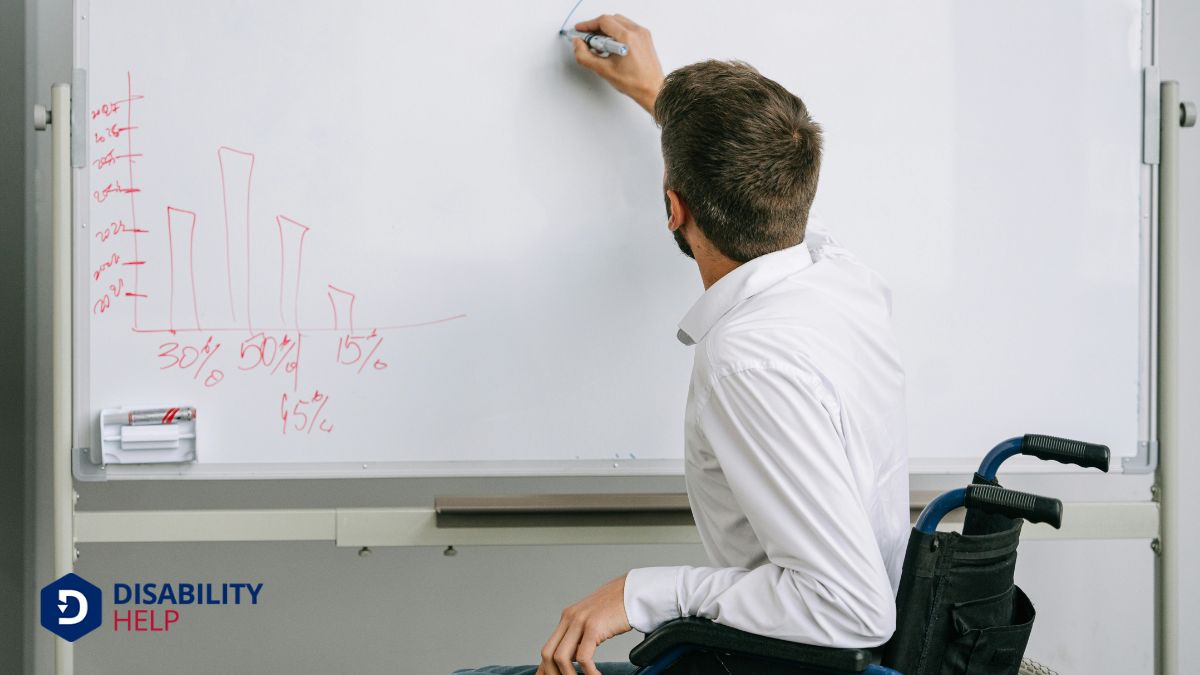To accomplish a 100% disability rating, we must focus on meeting eligibility criteria by proving how our condition greatly impairs daily activities and work. Gathering thorough medical documentation, including detailed records and statements from healthcare providers, is essential. We need to emphasize the daily impact of our disabilities through personal and employment records. Submitting a complete and accurate application with all necessary forms online or by post ensures we're on the right path. Staying organized can help manage any follow-up requests. If we pay attention to these steps, we'll potentially discover more valuable insights into this process.
Key Takeaways
- Gather comprehensive medical evidence showing the severe impact on daily life and work.
- Submit detailed medical records, including doctors' statements and treatment histories, to support your claim.
- Ensure your condition aligns with the VA's schedule for a 100% disability rating.
- Organize all documentation logically and meet all filing deadlines to avoid processing delays.
- Consider working with a skilled disability lawyer to strengthen your application and navigate complex procedures.
Understanding Disability Ratings
How exactly do disability ratings work? They're designed to evaluate how much a service-connected disability affects our ability to function in daily life and earn a living. The Department of Veterans Affairs (VA)A U.S. government agency that provides services and benefits to military veterans, including those w... assigns these ratings in percentages, from 0% to 100%, in increments of 10. Each percentage reflects the severity of the condition and its impact on our lives. For example, a 10% rating might suggest a minor impairmentA loss or abnormality of a body structure or function, whether physical, mental, or sensory, often a..., while a 100% rating indicates a total inability to work due to the disability.
The VA uses a schedule of ratings that align specific disabilities with corresponding percentage points. These ratings ultimately determine the amount of financial compensation we receive.
Importantly, multiple disabilities can be combined, but the process isn't a simple addition. Instead, the VA uses a formula that takes into account the most disabling conditions first, then adjusts for additional disabilities.
Understanding these ratings helps us navigate the compensation process more effectively. Knowing how ratings are assigned and calculated can empower us to guarantee we're receiving the benefits we deserve. By familiarizing ourselves with the system, we become better advocates for our own health and financial stability.
Eligibility Criteria Overview

To qualify for a 100% disability rating, understanding the eligibility criteria is necessary. We must first confirm that the condition we're dealing with is recognized by the relevant authority, such as the Department of Veterans Affairs (VA) for military-related disabilities. The condition should impair our ability to perform daily activities or work, which is essential for achieving a full disability rating.
Next, we need to think about how the disability affects our overall functioning. It's important that the impairment is severe enough to justify a 100% rating. The VA, for example, uses a schedule of ratings that evaluates the extent of disability based on specific criteria related to different conditions. We should familiarize ourselves with these criteria to see how they align with our situation.
Additionally, it's crucial to maintain a consistent medical history that supports our claim. Regular medical evaluations and documentation of ongoing treatment can strengthen our case. Understanding that the process may involve various assessments and re-evaluations will help us prepare for potential challenges.
Gathering Essential Documentation
Documentation serves as the backbone of a successful disability claim. As we embark on this journey together, gathering vital documentation is crucial. Let's focus on what we need: detailed medical records, in-depth evidence of your condition's impact on daily life, and any pertinent work history. These documents will form the foundation of our claim, clearly demonstrating the extent of your disability and why you qualify for 100% disability benefitsFinancial assistance provided to individuals who are unable to work due to a disability, such as Soc....
First, we should request copies of all medical records from healthcare providers. These records should include diagnoses, treatments, and ongoing care details. A well-documented medical history can greatly strengthen our claim.
We'll also need statements from doctors or specialists. These professionals can provide valuable insights into how your condition affects you, offering an expert perspective that supports our case.
Next, it's essential to document how your disability impacts your everyday activities. Personal statements, journals, or testimonies from family and friends can vividly illustrate these challenges. Additionally, gather employment records, especially if your condition has influenced your ability to work. This evidence will help us paint a complete picture of your situation.
Navigating the Application Process
With our detailed documentation in hand, we're ready to tackle the application process. It's crucial that we submit a complete and accurate application, as this can greatly impact the outcome.
Let's begin by visiting the official website of the organization responsible for processing disability claims. Here, we'll find the necessary forms and resources to guide us through each step. It's important to carefully read the instructions provided and fill out every section of the application.
We'll need to include all relevant personal information, details of our medical condition, and the impact it has on our daily lives. This is where our documentation comes in handy. By attaching medical records, doctor's notes, and any other supporting documents, we provide a detailed picture of our situation.
Submitting the application can be done online or by mail, but we should make sure we've copies of everything we send. It's also a good idea to note the submission date and any confirmation numbers provided, so we can track our application's progress.
Throughout this process, patience is key, as it may take time to hear back. Let's remain proactive and prepared for any follow-up requests.
Tips for a Strong Application
To enhance our disability application, we need to gather vital medical evidence that clearly outlines our condition.
Let's also focus on highlighting how our disability impacts our daily lives, illustrating the challenges we face.
Gather Essential Medical Evidence

Securing a 100% disability rating hinges on the strength of the medical evidence we present. To build a compelling case, we need to gather thorough and precise documentation of our medical condition. Start by obtaining all relevant medical records, such as doctors' notes, test results, and hospital discharge summaries. These documents should clearly outline our diagnosis and treatment history.
It's important to have detailed statements from our healthcare providers that describe our symptoms, limitations, and the impact on our daily lives. We should request letters from our doctors that emphasize the severity and permanence of our condition. These letters should connect medical findings to how our condition affects our ability to function.
Let's make sure that we include any lab tests or imaging studies that support our diagnosis. Consistency is key, so we should regularly update our medical records to reflect ongoing treatments or any changes in our condition. As we gather these documents, organizing them logically will make it easier for evaluators to follow our case.
Highlight Daily Life Impact
Now that we've gathered our medical evidence, we must focus on illustrating how our condition affects our daily lives. It's essential to convey the genuine impact of our disability, showing how it limits us from performing everyday tasks. We need to clearly articulate our struggles, whether it's difficulty with personal care, mobility challenges, or the inability to work. By painting a vivid picture of our daily experiences, we help decision-makers understand the extent of our limitations.
Let's consider specific examples. Describe how getting out of bed each morning is a challenge or how preparing a simple meal feels unattainable. If our condition impacts our mental health, we should explain how it affects our interactions with family and friends or limits our ability to concentrate. It's about making our story relatable and real.
Including testimonials from those who witness our daily struggles can strengthen our application. Statements from family, friends, or caregivers provide additional perspectives on how our condition affects us. These narratives, combined with our own, create a thorough understanding of our daily reality.
Common Mistakes to Avoid
Let's make certain we don't fall into common traps when seeking 100% disability. We should always guarantee our medical documentation is complete and thorough, as missing details can lead to delays or denials.
Additionally, ignoring filing deadlines can jeopardize our entire application, so let's keep a close eye on those dates.
Incomplete Medical Documentation
When pursuing a 100% disability rating, one of the most vital aspects is making sure that our medical documentation is thorough and accurate. We must provide extensive records that clearly define the extent of our disabilities. This means including detailed medical reports, diagnoses, treatment histories, and any test results that can support our claims.
A common mistake is submitting incomplete or outdated documents. We should double-check that all relevant information is up to date and that any recent medical evaluations are included. Remember, the more complete the documentation, the stronger our case will be.
It's essential to have our healthcare providers clearly outline how our disabilities impact our daily lives and ability to work. Vague or generalized statements can weaken our claims. We should ask for specific examples and make sure that the language used aligns with the criteria outlined by the disability rating authorities.
We should also avoid assuming that our claims are self-evident. Instead, we need to build a narrative with our medical documentation that leaves no room for doubt. Thorough, well-organized records can make a significant difference in achieving the disability benefits we're entitled to.
Ignoring Filing Deadlines
How often do we overlook important filing deadlines when pursuing a 100% disability rating? It's easy to lose track of time with so many other responsibilities on our plate. Yet, missing a deadline can set us back significantly. These deadlines aren't just suggestions; they're strict requirements that, if ignored, could delay or even jeopardize our entire claim process.
When we're dealing with disabilities, life can feel overwhelming, and the paperwork doesn't make it any easier. However, staying organized and aware of these deadlines is pivotal. Let's make it a priority to mark our calendars and set reminders. This proactive step guarantees we're meeting all required timeframes, whether it's submitting initial claims, responding to requests for additional information, or filing appeals.
We should also remember that each type of claim might've different deadlines. It's our responsibility to know these timelines and act accordingly. If we're ever unsure, let's not hesitate to reach out for help—whether it's through a trusted advisor or a veterans service organization. By staying vigilant and informed, we minimize the risk of setbacks and keep our path to obtaining a 100% disability rating as smooth as possible.
Medical Evidence Requirements

Medical proof is the foundation of any successful disability claim. Without it, our path to obtaining the disability benefits we deserve becomes much steeper. It's vital that we gather thorough and relevant medical records that demonstrate the severity and impact of our condition. These records include doctor's notes, diagnostic test results, treatment histories, and hospital records. When we compile these documents, it helps the decision-makers understand our struggles and the extent of our disability.
Let's make sure that the medical evidence we submit is up-to-date. Outdated information mightn't accurately represent our current condition. Regularly visiting our healthcare providers not only helps us maintain our health but also guarantees our records reflect the latest developments. We should also consider obtaining statements from our doctors that detail how our condition limits our ability to work or function daily.
It's important to present the evidence clearly. Organizing documents in a logical manner makes it easier for reviewers to assess our claim. If we're unsure about what's needed, consulting with a professional who specializes in disability claims can provide invaluable guidance. By focusing on strong medical evidence, we notably improve our chances of securing the benefits we seek.
Appealing a Denied Claim
Facing a denied disability claim can be disheartening, but it's important to remember that we have the right to appeal. The appeals process gives us a second chance to present our case and make sure that our needs are recognized.
First, we should carefully review the denial letter. It often contains specific reasons for the denial, which helps us understand what aspects of our application need strengthening.
Next, gathering additional evidence is vital. If our initial claim lacked certain medical documentation or personal statements, now's the time to include these. We might consider obtaining updated medical records or more detailed reports from our healthcare providers. These pieces of evidence can address the gaps identified in the denial letter.
When submitting our appeal, we need to adhere to deadlines, which are typically outlined in the denial notice. Missing these deadlines could jeopardize our chances of a successful appeal.
Working With a Disability Lawyer
Working with a disability lawyer can make all the difference in securing 100% disability benefits. We'll benefit from their expertise in choosing experienced legal representationThe way people with disabilities are depicted in media, culture, and politics, often influencing pub... and maneuvering the complex application processes. With their help, we can maximize our disability benefit claims and improve our chances of success.
Choosing Experienced Legal Representation
Managing the intricacies of disability claims can be overwhelming, and that's where selecting experienced legal representation becomes vital. We need someone who comprehends the detailed nuances of the process and can lead us through each stage.
When picking a disability lawyer, let's prioritize those with a proven history of handling similar cases. This experience equips them with the knowledge to anticipate potential obstacles and provide effective solutions.
A seasoned lawyer not only grasps the legal terminology but also knows how to present our case in the most persuasive manner. They'll make sure that we gather all necessary documentation and evidence to support our claim, enhancing our chances of success.
It's imperative to find someone we can communicate with openly, someone who'll listen to our concerns and respond to our questions clearly.
We should seek recommendations and reviews to identify potential candidates. Once we've a shortlist, let's schedule consultations to discuss our case and get a sense of how comfortable we feel with their approach.
Navigating Complex Application Processes

Embarking on the journey to secure disability benefits can feel overwhelming, but with the right guidance, we're not alone. Navigating the intricate application processes requires us to tackle numerous forms, medical records, and legal terminology. Working with a disability lawyer can make this challenging task more manageable. They comprehend the system's nuances and can provide clarity and support every step of the way.
A skilled lawyer helps us:
- Decipher Confusing Paperwork: They explain each document in simple terms, making sure we grasp what's needed.
- Organize Essential Evidence: They assist in gathering and presenting medical records that accurately reflect our condition.
- Meet Important Deadlines: They keep track of all submission dates so we don't miss any pivotal steps.
- Advocate for Our Rights: They represent us in hearings, presenting our case effectively to ensure our voice is heard.
Maximizing Disability Benefit Claims
Securing disability benefits is just the beginning; maximizing those claims guarantees we receive the full support we deserve. Working with a disability lawyer can greatly enhance our chances of maximizing these claims. They understand the intricate details of the system and help us navigate the complexities we might face.
First, a lawyer can examine our case thoroughly, identifying any areas where we might be missing out on additional benefits. They ensure that every piece of documentation and evidence is presented in the best possible way, aligning with legal standards. This attention to detail can make a substantial difference in the outcome of our claims.
Moreover, if we encounter any disputes or denials, a disability lawyer is equipped to handle appeals effectively. They advocate for us, making sure that our voice is heard and our rights are protected. This can alleviate much of the stress we might feel, allowing us to focus on our well-being.
In essence, partnering with a disability lawyer can streamline the process, increase our claim's success rate, and provide peace of mind. It's a strategic step toward receiving the full benefits we're entitled to, supporting our journey to a more secure future.
Maintaining Your Benefits
Ensuring we keep our benefits requires a proactive approach and a clear understanding of the necessary steps. It's essential to stay informed and organized so we don't risk losing the support that's critical for our well-being. By focusing on maintaining our benefits, we empower ourselves to secure our future. Let's discuss some key actions we can take.
- Stay Informed: Regularly review any changes in disability policies and guidelines. Knowledge is power, and staying updated helps us adaptA grassroots disability rights organization in the U.S. that focuses on promoting community-based se... quickly and effectively.
- Document Everything: Maintain detailed records of all medical appointments, treatments, and communications with the disability office. This documentation can be invaluable if we need to verify information or respond to inquiries.
- Timely Communication: Promptly report any changes in our medical condition, income, or personal circumstances. Keeping the disability office informed ensures that our benefits remain consistent with our current situation.
- Seek Support: Don't hesitate to reach out to support groups or legal advisors if we encounter difficulties. Having a support network can make navigating the system less intimidating and provide us with the guidance we need.
Conclusion
To sum up, we've explored the route to securing a 100% disability rating. By understanding the criteria, gathering essential documents, and maneuvering through the application process, we can strengthen our case. It's vital to provide strong medical evidence and consider appealing if necessary. Collaborating with a disability lawyer might be advantageous, too. Let's remember to maintain our benefits once they're granted. With persistence and preparation, we can achieve the support we deserve.






